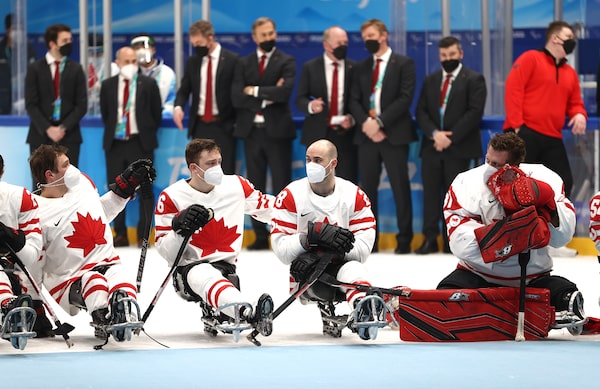
Team Canada accept their silver medals after the Gold Medal game at the Beijing 2022 Winter Paralympics at the National Indoor Stadium on March 13.Ryan Pierse/Getty Images
John Loeppky is a disabled freelance journalist living in Saskatoon.
For several months, Hockey Canada has been at centre ice of the national sports conversation. That ice is cracking. Sponsors have distanced themselves from the organization in the wake of a sexual-assault scandal and, this past week, chief executive officer Scott Smith departed along with the entire board of directors. But in all the articles and columns that have been published since the scandal became public earlier this year, I’ve read very little about where this leaves the country’s parahockey program.
To understand why this is a problem we first have to understand the Paralympic disciplines and their administrative structures. While all of the sports that compete at the Paralympics fall somewhere underneath the Canadian Paralympic Committee umbrella, how they exist within their national and often provincial sporting organizations can vary dramatically. Some sports, such as parahockey and para athletics, are integrated into the national governing organizations of their able-bodied counterparts. Others, including wheelchair rugby and wheelchair basketball, have their own separate non-profits.
Both models have advantages and disadvantages. On one hand, parahockey being so deeply connected to Hockey Canada brings with it – in good times, at least – the kind of name and brand recognition that, I’d argue, doesn’t exist anywhere else in Canadian Paralympic sport. On the other hand, when an organization as rotten to the core as Hockey Canada shows its true face, as we’re seeing now, a lack of funding clarity leaves the sport in the lurch.
And parahockey can’t afford this kind of uncertainty. Take the women’s team, which aren’t affiliated with Hockey Canada – meaning no financial support. The team has no paid staff, relying entirely on volunteers. While women can play for the Hockey Canada-backed national team, only three female athletes have ever competed in parahockey at the Paralympics for any nation. Not three for Canada – three worldwide. Parahockey is only a co-ed sport on paper. Point is, this is already a sport with inequity. Any reduction in funding will widen that gap.
Cut to sponsors announcing their decisions to pull their funding. Thus far, Tim Hortons has announced their commitments in relation to parahockey, vowing that they will continue to fund the sport, as well as women’s and youth hockey. Bauer has also confirmed their support for the para athletes, while Esso and Recipe Unlimited have not mentioned parasport specifically when speaking about their continued commitment to fund programs outside of the men’s team.
Part of the frustration being felt by some in the disability community stems from the fact that disabled people are often the last to get funding and the first ones to have it pulled. Being disabled is expensive, and so is running sporting programs meant for athletes with disabilities. But these programs are often working with much less than they need, let alone want. One only has to look at the historical medal bonus discrepancies between para and able-bodied athletes to see that parasport has continually been undervalued by those in power at Canadian sporting organizations.
So when a slew of sponsors announce that they are leaving the program, as they should, it would do a lot for the wider sporting landscape if parahockey were mentioned in more detail, and the commitment made to its players kept. Parahockey will never be the big money driver of these larger organizations, but when was that ever the purpose of sport? If these organizations and funders truly care about inclusion then they need to provide clarity to the public on what is and isn’t being defunded. Our athletes deserve that much. Canada’s parahockey team has medalled at the last three games. They should not be treated as an afterthought.
I’ve written before about how parasport will not grow to the size it can without proper critique, and that still holds true, but the reality is that a critical lens also has to be put on the sponsors of these programs. Without them, these opportunities do not exist. Canada’s parahockey players should not have to shoulder the weight of Hockey Canada’s mistakes. Sponsors should continue their support. A parahockey team isn’t just a nice to have, it’s a vital part of our sporting landscape. That deserves more than a footnote in a press release.